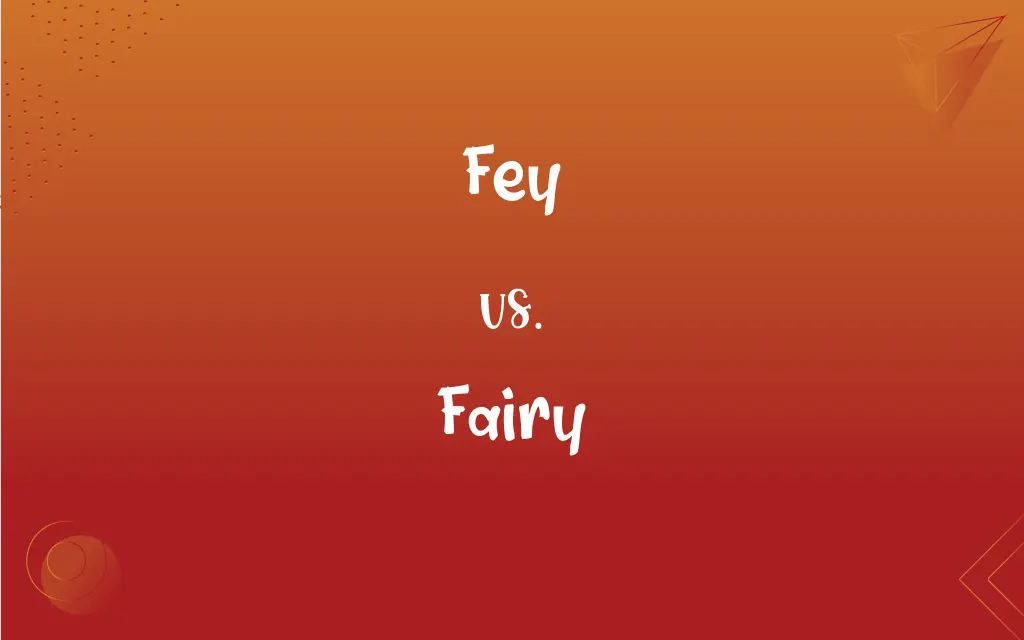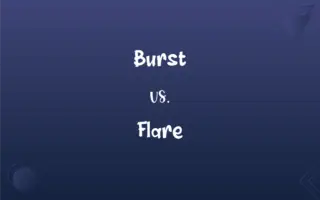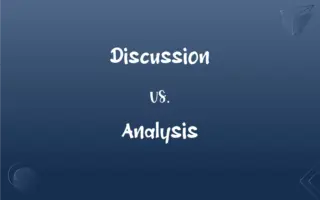Fey vs. Fairy: What's the Difference?
By Aimie Carlson & Janet White || Updated on March 4, 2024
Fey refers to otherworldly, magical qualities, while fairy denotes a mythical being or spirit.

Key Differences
Fey is an adjective describing something that is magical, mystical, or fairy-like in nature, often with an implication of being otherworldly or possessing supernatural qualities. This term can also imply a sense of foreboding or doom, especially in older or more poetic uses. On the other hand, a fairy is a noun that specifically refers to a type of mythical being or legendary creature, typically portrayed as human in appearance but with magical powers and sometimes wings, found in folklore and stories across many cultures.
While fey individuals or atmospheres are characterized by an enchanting or uncanny aura that suggests a connection to the supernatural or the fairy world, fairies themselves are the entities within this realm. Fairies are often depicted as playful, sometimes mischievous, and having a direct influence on the natural world. Conversely, something or someone described as fey might not directly interact with the physical realm but rather evoke a sense of enchantment or otherness that aligns with fairy-like mystique.
The use of fey in literature and speech often conveys a nuanced impression of beauty, strangeness, or preternatural insight, suggesting a link to the ethereal or the arcane. Whereas, the concept of fairies is deeply rooted in folklore and mythology, where they play specific roles ranging from guardians of nature to agents of change or mischief, influencing human affairs in myriad ways.
Culturally, the perception of what constitutes fey qualities can vary, encompassing everything from a peculiar charm to an unsettling, almost prophetic demeanor. In contrast, the depiction of fairies has evolved over time from ancient, formidable forces of nature to the more benign and diminutive figures popularized in Victorian literature and modern media.
Despite their differences, both fey and fairy elements often overlap in the realms of fantasy and mythology, where the boundaries between the ethereal qualities attributed to the fey and the tangible actions of fairies blur, enriching narratives with a blend of mysticism and tangible magical intervention.
ADVERTISEMENT
Comparison Chart
Nature
Adjective describing qualities
Noun referring to beings
Implication
Magical, otherworldly aura
Mythical creature with magical powers
Usage
Describes atmosphere, individuals, or qualities
Specifies a type of mythical being
Connotation
Enchanting, uncanny, sometimes ominous
Playful, mischievous, nature-bound
Cultural Perception
Varies from charm to prophetic insight
Evolved from formidable to benign
ADVERTISEMENT
Fey and Fairy Definitions
Fey
Associated with fairies or the supernatural.
The glen was known for its fey occurrences.
Fairy
A character in stories and legends, often benevolent.
The fairy godmother helped Cinderella attend the ball.
Fey
Having a visionary or dreamlike quality.
The poet's fey verses spoke of lands beyond the sea.
Fairy
A being capable of granting wishes or casting spells.
The fairy granted him three wishes.
Fey
Possessing an otherworldly, mystical charm.
The forest had a fey beauty under the moonlight.
Fairy
A small, mythical being with magical powers.
The child believed a fairy lived in the garden.
Fey
Overrefined, exaggerated, or affected
"She said the word in a deliberately fey and pretentious manner, striking a pose" (Jenefer Shute).
Fairy
A creature from folklore, often depicted with wings.
She dressed as a fairy for the costume party.
Fey
Effeminate
"a fey snap of the wrist" (Michael Eric Dyson).
Fairy
A mythical figure associated with nature and mischief.
Folk tales tell of fairies who protect the forest.
Fey
Having or displaying an otherworldly, magical, or fairylike aspect or quality
"She's got that fey look as though she's had breakfast with a leprechaun" (Dorothy Burnham).
Fairy
An imaginary being in human form, depicted as clever, mischievous, and possessing magical powers.
Fey
Having visionary power; clairvoyant.
Fairy
The realm of faerie; enchantment, illusion.
Fey
Appearing touched or crazy, as if under a spell.
Fairy
A mythical being with magical powers, known in many sizes and descriptions, although often depicted in modern illustrations only as a small sprite with gauze-like wings, and revered in some modern forms of paganism.
Fey
Fated to die soon.
Fey
Full of the sense of approaching death.
Fey
About to die; doomed; on the verge of sudden or violent death.
Fey
(obsolete) Dying; dead.
Fey
Possessing second sight, clairvoyance, or clairaudience.
Fey
Overrefined, affected.
Fey
Strange or otherworldly.
Fey
Spellbound.
Fey
Magical or fairylike.
Fey
Fairy folk collectively.
Fey
Fated; doomed.
Fey
Faith.
Fey
To cleanse; to clean out.
Fey
Slightly insane
Fey
Suggestive of an elf in strangeness and otherworldliness;
Thunderbolts quivered with elfin flares of heat lightning
The fey quality was there, the ability to see the moon at midday
Fey
Slightly strange or enchanting in a way that suggests supernatural influence.
Her fey smile hinted at hidden knowledge.
Fey
Marked by a foreboding of death or calamity.
He had a fey look about him that night.
FAQs
Is the concept of fey limited to Western cultures?
While the term "fey" has roots in Western folklore and literature, the concept of mystical or otherworldly qualities is universal, though different cultures may use other terms or concepts.
How do fairies typically interact with humans?
Fairies might interact with humans in various ways, from granting wishes and offering guidance to playing tricks or imposing challenges.
Can places or objects be fey?
Yes, locations or items can be described as fey if they evoke a sense of enchantment or otherworldliness.
Are there modern representations of fey qualities?
Yes, fey qualities are often explored in contemporary fantasy literature and media, depicting characters or settings with an aura of enchantment or otherness.
How do different cultures portray fairies?
Cultural portrayals of fairies vary widely, from the nature spirits of European folklore to similar beings in other cultures, such as the Japanese "Yokai" or the "Djinn" in Middle Eastern traditions, each with unique traits and stories.
What does it mean when someone is described as fey?
It suggests they have a mysterious, otherworldly quality or charm, possibly hinting at supernatural connections or insights.
What is the origin of fairies in folklore?
Fairies have origins in the mythologies and folklore of many cultures, often linked to nature spirits, ancestral spirits, or deities.
Can the term fey have negative connotations?
Yes, in some contexts, fey can imply a sense of doom or foreboding, as well as being too otherworldly or detached from reality.
Are all fairies considered fey?
While fairies are inherently associated with magical qualities that could be described as fey, not everything fey is a fairy.
Do fairies always have wings?
Not always; while many popular depictions include wings, traditional folklore presents a wide variety of fairies, not all of whom have wings.
Is there a specific time of day when fey or fairy activities are said to be more prevalent?
Twilight, dawn, and midnight are traditionally considered times when the veil between the human world and the fairy realm is thinnest, making fey and fairy activities more likely to occur.
How have perceptions of fairies changed over time?
Perceptions have shifted from viewing fairies as powerful and sometimes dangerous beings in ancient folklore to more whimsical, benign figures in modern times, reflecting changing cultural attitudes towards the supernatural.
What role do fairies play in environmental conservation in folklore?
In folklore, fairies are often depicted as guardians of nature, protecting forests, waters, and wildlife, thus embodying the principles of environmental conservation and respect for the natural world.
Can fey qualities be seen as a gift or a curse?
In folklore and literature, fey qualities can be depicted as both a gift, offering insight or magical abilities, and a curse, isolating individuals from the rest of humanity due to their otherworldly nature.
How can one attract or repel fairies, according to folklore?
Folklore suggests various methods for attracting fairies, such as leaving offerings of food or shiny objects, and repelling them with iron, salt, or specific herbs, reflecting the complex relationship between humans and the fairy world.
Can someone or something become fey, or is it an inherent quality?
Feyness is typically considered an inherent quality or aura, but literature and folklore sometimes depict individuals or places becoming fey through magical influence or significant events.
What is the significance of fairy rings in folklore?
Fairy rings, naturally occurring circles of mushrooms, are mythologized in folklore as gateways to the fairy realm or as places where fairies dance, imbued with magic and a sense of mystery.
Are there any historical figures known for their fey qualities?
Throughout history, certain individuals, such as the Irish pirate queen Grace O'Malley or the Scottish prophetess the Brahan Seer, have been described posthumously as having fey qualities, due to their extraordinary lives or purported supernatural abilities.
How do fairies communicate with humans in stories?
Fairies are often depicted as using telepathy, dreams, signs in nature, or direct speech to communicate with humans, depending on the story's context and the fairy's intentions.
What are the consequences of breaking a fairy's rules?
In folklore, breaking a fairy's rules can lead to misfortune, enchantments, or being taken to the fairy realm, emphasizing the importance of respect and caution in dealings with the fey.
About Author
Written by
Aimie CarlsonAimie Carlson, holding a master's degree in English literature, is a fervent English language enthusiast. She lends her writing talents to Difference Wiki, a prominent website that specializes in comparisons, offering readers insightful analyses that both captivate and inform.
Co-written by
Janet WhiteJanet White has been an esteemed writer and blogger for Difference Wiki. Holding a Master's degree in Science and Medical Journalism from the prestigious Boston University, she has consistently demonstrated her expertise and passion for her field. When she's not immersed in her work, Janet relishes her time exercising, delving into a good book, and cherishing moments with friends and family.































































